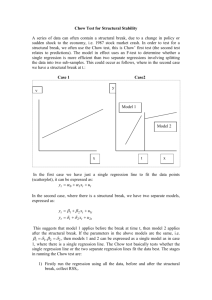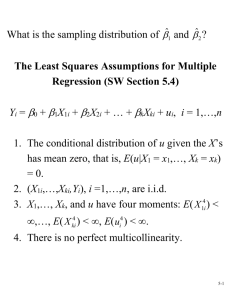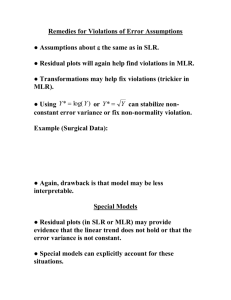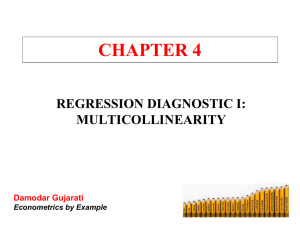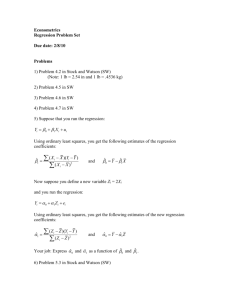Multicolinearity - gwilympryce.co.uk
advertisement
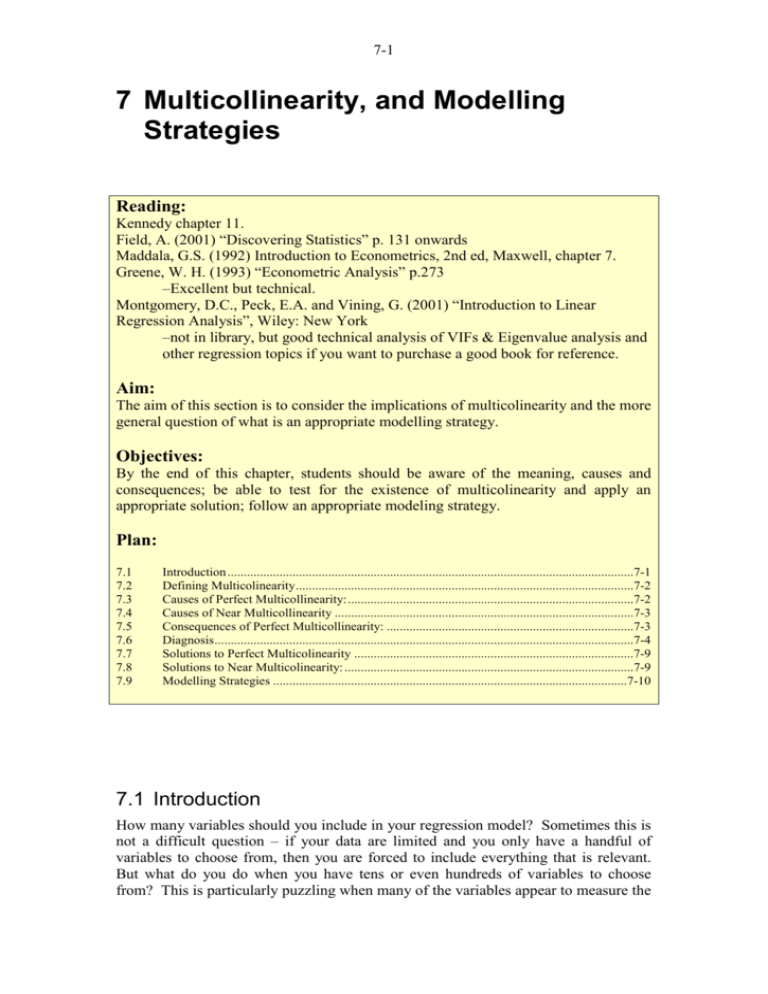
7-1 7 Multicollinearity, and Modelling Strategies Reading: Kennedy chapter 11. Field, A. (2001) “Discovering Statistics” p. 131 onwards Maddala, G.S. (1992) Introduction to Econometrics, 2nd ed, Maxwell, chapter 7. Greene, W. H. (1993) “Econometric Analysis” p.273 –Excellent but technical. Montgomery, D.C., Peck, E.A. and Vining, G. (2001) “Introduction to Linear Regression Analysis”, Wiley: New York –not in library, but good technical analysis of VIFs & Eigenvalue analysis and other regression topics if you want to purchase a good book for reference. Aim: The aim of this section is to consider the implications of multicolinearity and the more general question of what is an appropriate modelling strategy. Objectives: By the end of this chapter, students should be aware of the meaning, causes and consequences; be able to test for the existence of multicolinearity and apply an appropriate solution; follow an appropriate modeling strategy. Plan: 7.1 7.2 7.3 7.4 7.5 7.6 7.7 7.8 7.9 Introduction .............................................................................................................................7-1 Defining Multicolinearity ........................................................................................................7-2 Causes of Perfect Multicollinearity: ........................................................................................7-2 Causes of Near Multicollinearity ............................................................................................7-3 Consequences of Perfect Multicollinearity: ............................................................................7-3 Diagnosis .................................................................................................................................7-4 Solutions to Perfect Multicolinearity ......................................................................................7-9 Solutions to Near Multicolinearity: .........................................................................................7-9 Modelling Strategies .............................................................................................................7-10 7.1 Introduction How many variables should you include in your regression model? Sometimes this is not a difficult question – if your data are limited and you only have a handful of variables to choose from, then you are forced to include everything that is relevant. But what do you do when you have tens or even hundreds of variables to choose from? This is particularly puzzling when many of the variables appear to measure the 7-2 same (or similar) phenomenon. Even when you have a handful of variables at your disposal, two or three of them might still be measuring the same thing or likely to be highly correlated with one another even though they are all considered by your theory to be independent variables. This chapter examines these questions and the broader issue of choosing an appropriate modelling strategy. 7.2 Defining Multicolinearity Multicollinearity occurs when the explanatory variables are highly intercorrelated. This may not necessarily be a problem, but it can prevent precise analysis of the individual effects of each variable. Consider the case of just k = 2 explanatory variables and a constant. For either slope coefficient, the square of the standard error is: Var[bk ] 2 (1 r122 ) ( xik xk ) 2 i If the two variables are perfectly correlated, r122 = 1 (where r122 is the square of the simple correlation coefficient between x1 and x2), then the variance of the estimated slope coefficient will be infinite: Var[bk ] 2 (1 r122 ) ( xik xk ) 2 2 0 i Perfect multicollinearity usually only occurs because of model misspecification rather than measurement problems. The more common case is where the variables are highly but not perfectly correlated. 1. What happens to the standard errors of estimated coefficients on explanatory variables if the explanatory variables are highly correlated with each other? 2. Why do you think this might this be a problem? 7.3 Causes of Perfect Multicollinearity: The most common cause of multicollinearity is the “dummy variable trap” – the failure to exclude one category when using dummy variables to measure categorical determinants. A similar cause is that of including a variable that is computed from other variables in the equation. For example, if one were to compute: family income = husband’s income + wife’s income, and then include all three measures in a regression, the result would be perfect multicollinearity since one variable (family income) is a linear combination of the other two. A third possible cause is the inclusion of the same, or almost the same, variable twice. An example would be the inclusion of two variables measuring height, the only difference between them being that one is measured in feet and the other in inches. All of the above imply some sort of error on the researcher’s part. But, it is possible that different causes happen to be highly correlated or that measurement methods fail 7-3 to distinguish the underlying concepts we believe to be causes of y. These rarely produce perfect multicolinearity but can be problematic nonetheless. 7.4 Causes of Near Multicollinearity The most common cause here is measurement problems where the variables to be measured were not defined in a way that would allow the separation of different effects when the variables come to be analysed (this is why one should really understand the modelling process before collecting data). 3. What is meant by the “dummy variable trap”? 4. Consider any instances in your own research/reading where it has proved difficult to measure the role of a particular influence with a single measure. 7.5 Consequences of Perfect Multicollinearity: Suppose we attempt to estimate the following regression (Greene p. 267): Consumption = b1 + b2 nonlabour income + b3 salary + b4 total income. It will not be possible to separate out individual effects of the components of income (N + S) and total income (T). This can be seen if we write the “structural” (I.e. the one we expect in theory) equation as: Chat = b1 + b2N + b3S + b4T and add any nonzero value (e.g. 3) to the coefficients: Chat = b1 + (b2 +3) N + (b3 +3) S + (b4 +3) T. What we find is that the equation would still be true if we added 4 or 4.25 or any value to the coefficients. In other words, this regression specification allows the same value of Chat for many different values of the slope coefficients. This is called the “identification problem” and most statistical packages will come up with an appropriate error message if you try to run a regression suffering from perfect multicollinearity. Note, though, that this is a poorly specified model and the problems of identification have nothing to do with the quality of the data. 5. What do we mean when we say that one variable is a “linear combination” of another? Think of a possible example (preferably in your own field of interest/research). 7.5.1 Consequences of Near Multicollinearity: When the correlation between explanatory variables is high but not perfect, then the difficulty in estimation is not one of identification but of precision. The higher the correlation between the regressors, the less precise our estimates will be (i.e. the greater the standard errors on the slope parameters): 7-4 Var[bk ] 2 (1 r122 ) ( xik xk ) 2 i But even where there is extreme multicollinearity, so long as it is not perfect, OLS assumptions will not be violated and OLS estimates of that particular model are still BLUE (Best Linear Unbiased Estimators). Alterations to the model, however, may increase efficiency (i.e. reduce the variance of the estimated slopes) When high multicollinearity is present, confidence intervals for coefficients tend to be very wide and t-statistics tend to be small. Note, however, that large standard errors can be caused by things other than multicollinearity (such as a large standard error of the residuals, 2, which is symptomatic of a model that poorly fits the data). When two explanatory variables are highly and positively correlated, their slope coefficient estimators will tend to be highly and negatively correlated. But a different sample could easily produce the opposite result if there is multicollinearity because coefficient estimates tend to be very unstable from one sample to the next and can result in estimates of implausible magnitude. 7.6 Diagnosis A. Check the t ratios: If none of the t-ratios for the individual coefficients are statistically significant, yet the overall F statistic is, then there is again a good chance that you may have multicolinearity, particularly if some of the coefficients on explanatory variables have implausible signs or magnitudes. Note, however, the following word of caution from Greene: “It is tempting to conclude that a variable has a low t ratio, or is significant, because of multicollinearity. One might (some authors have) then conclude that if the data were not collinear, the coefficient would be significantly different from zero….Of course, this is not necessarily true. Sometimes a coefficient turns out to be insignificant because the variable does not have any explanatory power in the model” 6. Open up Nationwideextract data and run a regression of purchase price on number of bathrooms, number of bedrooms, floor area, and date built. Comment on your results in terms of the possible existence of multicolinearity and whether you think it would be worthwhile investigating further. B. Check for unstable parameter values across subsamples: Step 1: create an arbitrary random variable, Q and order your sample by Q (alternatively you can use the random sub-sample facility in SPSS entering TEMPORARY. new line, then SAMPLE = 0.5) 7-5 Step 2: run the same regression on different sub-samples (e.g. first 100 observations vs rest) Step 3: do F-tests to see if the slopes change 7. Run the above regression again on a randomly drawn 50% subsample using the syntax below. Have any of the coefficients changed to any noticeable extent? TEMPORARY. SAMPLE 0.5. REGRESSION /MISSING LISTWISE /STATISTICS COEFF OUTS R ANOVA /CRITERIA=PIN(.05) POUT(.10) /NOORIGIN /DEPENDENT purchase /METHOD=ENTER bathroom bedrooms floorare dtbuilt . 8. Run the syntax a couple of more times to see if the slope coefficients change and try altering the size of the random sub-sample (e.g. increase the proportion to 0.7). 9. (Optional) Run F-tests to formally ascertain whether the slope coefficients are stable across sub-samples. C. Check for unstable Parameters Across Specification: Try a slightly different specification of a model using the same data. See if seemingly “innocuous” changes (e.g. adding a variable, dropping a variable, using a different operationalization of a variable) produce big shifts. If so, then there’s a good chance that this is caused by multicolinearity. As variables are added, look for changes in the signs of effects (e.g. switches from positive to negative) that seem theoretically questionable/inexplicable. 10. Run the original regression again on the full sample but drop out floor area from the list of explanatory variables. How have the remaining slope coefficients and other regression outputs changed from the original regression? What does this tell you? 11. Now re-enter floorarea and drop out number of bedrooms. How have the remaining slope coefficients and other regression outputs changed from the original regression? What does this tell you? 7-6 D. Check the Simple Correlation Matrix: The simple correlation coefficient, rxz, is the covariance of x and z divided by the product of the standard deviation of x and z. It has the same sign as the covariance but only varies between -1 and 1 and is unaffected by any scaling of the variables. rxz xz x z This measure is useful if we have only two explanatory variables. If the number of explanatory variables is greater than 2, the method is useless since near multicolinearity can occur when any one explanatory variable is a near linear combination of any collection of the others. Thus, it is quite possible for one x to be a linear combination of several other x’s, and yet not be highly correlated with any one of them (i.e. each of the correlation coefficients may be small, but the R2 between the explanatory variables may be high). 12. Use the following syntax to check the bivariate correlation between floorarea and number of bedrooms (alternatively, go to Analyse, Correlate, Bivariate, and check the Pearson option). Do the correlation results suggest multicolinearity? CORRELATIONS /VARIABLES=bedrooms floorare /PRINT=TWOTAIL NOSIG /MISSING=LISTWISE . 13. Use the syntax to check for correlations between other pairs of explanatory variables. What is the drawback of this method in the context of your original regression? E. Check Rk2 When you have more than one explanatory variable, you could run regressions of each on the others to see if there is multicollinearity. This is probably the best way of investigating multicollinearity since examining coefficients will also help you find the source of the multicollinearity. If you have lots of regressors, however, this can be a daunting task, so you may want to start by looking at the Tolerance and VIF (see below). 14. Run a regression of floor area on the remaining explanatory variables and comment on your results in terms of their implications for the existence of multicolinearity. 15. Run a regression of number of bathrooms on the remaining explanatory variables and comment on your results in terms of their implications for the existence of multicolinearity. 7-7 F. Check the Tolerance and VIF The general formula (as opposed to the one where you have just 2 regressors) for the variance of the slope coefficient estimate is: Var[bk ] 2 (1 Rk2 ) ( xik xk ) 2 i where Rk2 is the squared multiple correlations coefficient between xk and the other explanatory variables (for example, the R2 from the regression: x1 = a1 + a2x2 + a3x3). “1 - Rk2” is referred to as the Tolerance of xk. A tolerance close to 1 means there is little multicollinearity, whereas a value close to 0 suggests that multicollinearity may be a threat. The reciprocal of the tolerance is known as the Variance Inflation Factor (VIF). The VIF shows us how much the variance of the coefficient estimate is being inflated by multicollinearity. A VIF near to one suggests there is no multicolinearity, whereas a VIF near 5 might cause concern. Example: Model of House Prices Coefficientsa Model 1 (Constant) Bedrooms PublicRooms HasGarden Time on the Market (number of days) Unstandardized Coefficients B Std. Error -5863.031 674.178 12885.593 280.324 26431.578 439.243 347.620 516.156 -15.213 1.289 Standardi zed Coefficien ts Beta .344 .434 .005 t -8.697 45.967 60.175 .673 Sig. .000 .000 .000 .501 -.076 -11.798 .000 Collinearity Statistics Tolerance VIF .730 .785 .843 1.371 1.273 1.186 .997 1.003 a. Dependent Variable: SellingPrice All the VIF levels in the above regression are near to one so there is no real problem. If VIF where high for a particular regressor, say z, then we might want to run a regression of z on the other explanatory variables to see variables are closely related. We could then consider whether to omit one or more of the variables (if on deliberation we decide that they are in fact measuring the same thing). 16. Add “TOL” to the list of statistics called up your regression syntax (see below) to calculate the Tolerance and VIF for each explanatory variable for your original regression (alternatively, go to Analyse, Regression, Linear, select your variables, then click on Statistics and check the Colinearity Diagnostics option). What do the Tolerance and VIF figures tell you? REGRESSION /MISSING LISTWISE /STATISTICS COEFF OUTS R ANOVA /CRITERIA=PIN(.05) POUT(.10) /NOORIGIN TOL 7-8 /DEPENDENT purchase /METHOD=ENTER bathroom bedrooms floorare dtbuilt . G. Check the Eigenvalues and Condition Index: Eigenvalues indicate how many distinct dimensions there are among the regressors. When several eigenvalues are close to zero, there may be a high level of multicolinearity. Condition Indices are the square roots of the ratio of the largest eigenvalue to each successive eigenvalue. Values above 15 suggest a possible problem, and values over 30 suggest a serious problem with multicolinearity. The variance proportions are the proportions of the variance of the estimate accounted for by each principal component associated with each of the eigenvalues. Multicollinearity is a problem when a component associated with a high condition index contributes substantially to the variance of two or more variables. Collinearity Diagnosticsa Variance Proportions Model 1 Dimension 1 2 3 4 5 Eigenvalue 4.028 .597 .211 8.810E-02 7.643E-02 Condition Index 1.000 2.597 4.370 6.761 7.259 (Constant) .01 .00 .04 .12 .83 Bedrooms .01 .01 .03 .39 .57 PublicRo oms .01 .01 .09 .86 .03 HasGard en .01 .04 .92 .03 .01 Time on the Market (number of days) .02 .88 .05 .01 .05 a. Dependent Variable: SellingPrice In the Collinearity Diagnostics for the House Price regression, it can be seen that two of the eigenvalues are pretty small, but the Condition Indices are all below 10 so there is unlikely to be a problem with multicolinearity here. Problems with the Condition Index Approach: The condition number can change by a reparametrization of the variables: “it can be made equal to one with suitable transformations of the variables” (Maddala, p. 275). Such transformations can be meaningless. Also, the CI approach does not tell you whether the multicolinearity is actually causing problems or how to go about resolving the problems if they exist. 17. Add “COLLIN” to the list of statistics called up your regression syntax (see below) (alternatively, go to Analyse, Regression, Linear, select your variables, then click on Statistics and check the Colinearity Diagnostics option). What do the Eigenvalue and Condition Index figures tell you? REGRESSION /MISSING LISTWISE /STATISTICS COEFF OUTS R ANOVA COLLIN /CRITERIA=PIN(.05) POUT(.10) /NOORIGIN /DEPENDENT purchase /METHOD=ENTER bathroom bedrooms floorare dtbuilt . 7-9 18. For the two highest condition indices recorded, consider whether any of the variables has a high variance proportion? If so, what does this tell you? Does this confirm what you have found in your other investigations of multicolinearity in this regression above? 7.7 Solutions to Perfect Multicolinearity Check whether you have made any obvious errors, such as the improper use of computed or dummy variables (particularly for perfect multicolinearity) and rectify accordingly. 7.8 Solutions to Near Multicolinearity: NB: only needs “solving” if it is having an adverse effect on your model such as large SEs, unstable signs on coefficients. 7.8.1 Alternative Estimation Techniques Solutions that have been proposed include: Factor analysis, Principle components or some other means to create a scale from the X’s. This solution is not recommended in most instances since the meaning of coefficients on your created factors will be difficult to interpret: “First, the results are quite sensitive to the scale of measurement in the variables. The obvious remedy is to standardize the variables, but, unfortunately, this has substantial effects on the computed results. Second, the principle components are not chosen on the basis of any relationship of the regressors to y , the variable we are attempting to explain. Lastly, the calculation makes ambiguous the interpretation of results. The principle components estimator is a mixture of all of the original coefficients. It is unlikely that we shall be able to interpret these combinations in any meaningful way.” (Greene p. 273) 7.8.2 Use joint hypothesis tests: If the t-values on individual xs are low and if you think this is because there is a degree of multicolinearity amongst some of the variables (e.g. a group of the xs are measuring related aspects of the same underlying phenomenon), then in addition to doing t-tests for individual coefficients, you could do an F test for a group of coefficients. So, if x1, x2, and x3 are highly correlated, do an F test of the hypothesis that b1 = b2 = b3 = 0. 7.8.3 Omitted Variables Estimation: The most obvious solution to multicolinearity is to “drop” the offending variable(s). But, if the variable really belongs in the model, this can lead to specification error, which can have significantly worse consequences (i.e. bias) than a multicollinear model (which is BLUE). 7.8.4 Ridge Regression: Deliberately adds bias to the estimates to reduce the standard errors 7-10 “it is difficult to attach much meaning to hypothesis tests about an estimator that is biased in an unknown direction” (Greene) 19. Assuming that the only option open to you to deal with multicolinearity is to delete offending variables, would you delete any variables from your original regression given the diagnostic test results you have analysed so far? Even if there is evidence of multicolinearity, what other factors should you take into account before deleting a variable from the regression? 7.9 Modelling Strategies Whether or not you present the results of the diagnostics to your audience, you MUST construct your model using them. Otherwise, how do you know that you have specified it correctly and how do you know that it can be generalised beyond your sample? 7.9.1 A Salutary Tale… You constructed the following model of mortality rate: Mortality Rate = b1 + b2 Smoking Rate + b3 Average Age buy you did not include in your model a whole range of variables because when you entered them in individually, there were not significant (I.e. t < 2). However, it turns out that your model suffered from heteroscedasticity and so the t-tests were incorrect. If you had used White’s SEs , you would have found that in fact, Unemployment and School Achievement were both significant determinants. You used simple correlation coefficients between variables to identify multicollinearity, which resulted in Smoking Rate and Age being kept in the model but Unemployment and other variables being dropped. However, your method was spurious: you should actually have dropped age and kept Unemployment and School Achievement You did not test for parameter stability across subsamples and so you did not realise that in fact your model was not stable across different parts of the country or over time. In some areas, unemployment was actually the most important driver and estimates based on a subsample of the most recent 4 years showed unemployment to have a much larger coefficient than what you found in early runs of your model on the whole sample. Your model was actually totally inapplicable to certain areas (Highlands) and subsample Chow tests would have revealed this. You did not check for non-linearities or interactive effects, but it 7-11 turns out that there is a highly significant quadratic relationship with unemployment and a strong interaction with whether or not the area is urban. CONCLUSION: Your model is USELESS!!! Worse than that, it is misleading and could distort policy outcomes. A few years later, other models are developed (with equal disregard to diagnostics) which produce completely different results. As a result, policy makers become disillusioned with statistical models and resort to their own “good judgement” (worst case scenario)! The world comes to an end an it was all YOUR fault!!! 7.9.2 General to Specific To avoid this nightmare scenario you need a sound modelling strategy. I would recommend using the General to Specific modelling strategy where you start with all variables available and the full sample and then reduce & refine as necessary both the variables and sample as necessary. Another valid approach (if done correctly) is the Specific to General method, where you start with few variables & a specific sample. You then expand & refine the model incrementally. One balance, I would recommend the first of these approaches, but both are defensible if used in conjunction with thorough diagnostic testing. General to Specific model steps: (i) Theory Always start with theory where possible. Try to cater for all possible determinants Try to identify specific hypotheses you want to test (ii) Anticipated Regression Model identify the regression model that follows from your theory and that will allow you to test the hypotheses you are most interested in. (iii) Data Collection & Coding make sure the data you collect, the way you collect it (i.e. unbiased sampling, large n, precise measurement) & the coding will allow you to build your general model and test specific hypotheses. if you are using secondary data, be aware of the sampling and coding issues associated with the data. 7-12 (iv) General Model attempt your first regression model using the data available: start with all available variables and all available observations make obvious modifications before starting the diagnostic/refinement process (v) Diagnostic Checks and Refinement Examine Residual plots scatter plots of residuals on y & xs should be “spherical” normal probability plots outliers (use Cook’s distances etc.) Heteroscedasticity Test using B-P etc. If heteroskedasticity exists, use White’s SEs & Chow’s 2nd Test Wrong signs and Mispecification t-tests & multicollinearity tests RAMSEY reset test. Non-linear Transformations interactions Low Adjusted R2 Transform variables drop irrelevant variables get data on new variables F-Tests structural stability (Chow) linear restrictions Multicolinearity check VIF, eigenvalues, Condition indices etc. present joint hypothesis tets. (vi) Specific Model should be “well behaved” stable passes general misspecification tests if possible e.g. RESET test coefficients should be meaningful do the coefficients make sense? How do they relate to your theory/intuition? Alternative explanations/interpretations (vii) Revise Theory? Do your empirical results mean that you need to modify your initial theory, hypotheses and Anticipated Regression Model? 7-13 Often, it is only when you start the empirical process that you really grasp the key aspects or limitations of your theory (iix) Present the Final model (to an academic audience: e.g. journal article) you should present your (revised) theory first then the (revised) anticipated regression model then discuss the data and measurement of (revised) anticipated variables then present a selection of regression models present a series of “preferred” regressions which might vary by: selection of regressors measurement of dependent variable and/or sample selection present the selection of regressions in columns all in a single table rather than as separate tables -- this will assist comparison only present statistics that you explain/discuss in your text always present sample size, Adjusted R2, t values on individual coefficients or SEs or Sig. then offer a full discussion I.e. of the different regressions and statistics that you have presented and discuss any relevant elements of the refinement process this discussion should lead you to select a final “preferred” model(s) (if there is one) on the basis of the diagnostics, intuition and relevance to the theory it is a good idea to present this in a separate table in more detail -- e.g. with confidence intervals for the coefficients you should comment on the limitations of you model given the data and the anticipated effect of measurement problems, omitted variables, bias in sample, insufficient sample size etc. Then present the results of your specific hypothesis tests these should be run on your final preferred model(s) and include a full discussion of their meaning and the limitations implied by the inadequacies of your model. If you are presenting to a non-academic audience, you will have to select which of the above are likely to be most meaningful/important to them. Whether or not you present the results of the diagnostics, you MUST construct your model using them otherwise: how do you know that you have specified it correctly? How do you know that it can be generalised beyond your little sample!?
